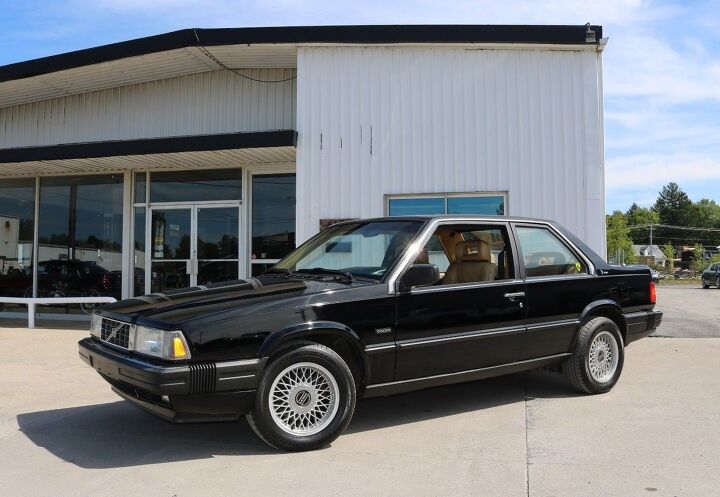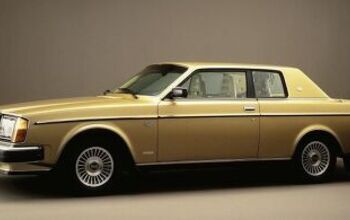Rare Rides: A Bertone by Any Other Name, the 1989 Volvo 780

What do you get when you cross practical Swedish design sensibility with some Italian flair? You get a very expensive and boxy two-door sedan with a Bertone badge on it.
Presenting the 1989 Volvo 780.
Design firm Bertone was used to putting their own spin on existing cars. In fact, the predecessor to today’s Rare Ride was the Bertone-built and chopped roof Volvo 262C, of 1978 through 1981. That car was the first time Volvo aimed their sights at the luxury car market. Pitching the 262C against established players like Cadillac and Mercedes-Benz, Volvo moved 6,622 copies of the thoroughly Malaise 262C.
Pleased with the result of their prior collaboration, Volvo turned to the Italian house once more, and said “Coupe again!” After a Swiss debut in 1985, the 780 made its way to the United States for the 1987 model year.
Based on the successful line of 700 series cars from Volvo, the 780 was top of the line. The only way to get anything but a standard sedan or wagon was to pass by the 740 and 760 models, and pony up for the Bertone 780.
All 780s were built at the Bertone factory in Turin, Italy. The coachbuilder reworked the original 760’s roof into a coupe format, and rearranged the hood and trunk to sit lower. At the rear the C-pillar had a smoother rake, which gave a faster silhouette when compared to the upright sedans. Learning from their prior experience, Bertone didn’t chop the roof like they did with the 262C, leaving headroom intact.
The first couple years of 780 production were hampered a bit by a single engine up front, a solid rear axle underneath, and a lousy climate control system in the middle. Originally Volvo offered the 3,400-pound 780 with the 2.8-liter PRV V6 (150 horsepower) in naturally aspirated guise. Volvo improved offerings for the ’88 model year; at that point an upgrade to the independent rear suspension coincided with the availability of turbocharged inline-four engines. One-hundred and seventy-five turbocharged horsepower in 1988 increased to 188 in North American cars for 1989 and onward. Four-speed manual or automatic transmissions were available, with the majority of North American examples possessing an automatic.
The 780 would live for a relatively short while overall. Production wrapped up in 1990, resulting in a limited run ’91 model year. For that year only, the 780 name disappeared and badging simply read Coupé. Volvo produced 8,518 Bertone 780s in total. Perhaps taking a hint from the market, the company did not offer another coupe until the more modern C70 arrived for 1996.
Today’s Rare Ride is a relatively clean 1989 example, on offer via a dealer recently. It was bid up to $1,960 and did not meet the reserve. Still listed on the dealer’s site, the 780 asks $4,900.
[Images: seller]

Interested in lots of cars and their various historical contexts. Started writing articles for TTAC in late 2016, when my first posts were QOTDs. From there I started a few new series like Rare Rides, Buy/Drive/Burn, Abandoned History, and most recently Rare Rides Icons. Operating from a home base in Cincinnati, Ohio, a relative auto journalist dead zone. Many of my articles are prompted by something I'll see on social media that sparks my interest and causes me to research. Finding articles and information from the early days of the internet and beyond that covers the little details lost to time: trim packages, color and wheel choices, interior fabrics. Beyond those, I'm fascinated by automotive industry experiments, both failures and successes. Lately I've taken an interest in AI, and generating "what if" type images for car models long dead. Reincarnating a modern Toyota Paseo, Lincoln Mark IX, or Isuzu Trooper through a text prompt is fun. Fun to post them on Twitter too, and watch people overreact. To that end, the social media I use most is Twitter, @CoreyLewis86. I also contribute pieces for Forbes Wheels and Forbes Home.
More by Corey Lewis
Latest Car Reviews
Read moreLatest Product Reviews
Read moreRecent Comments
- Kwik_Shift_Pro4X Thankfully I don't have to deal with GDI issues in my Frontier. These cleaners should do well for me if I win.
- Theflyersfan Serious answer time...Honda used to stand for excellence in auto engineering. Their first main claim to fame was the CVCC (we don't need a catalytic converter!) engine and it sent from there. Their suspensions, their VTEC engines, slick manual transmissions, even a stowing minivan seat, all theirs. But I think they've been coasting a bit lately. Yes, the Civic Type-R has a powerful small engine, but the Honda of old would have found a way to get more revs out of it and make it feel like an i-VTEC engine of old instead of any old turbo engine that can be found in a multitude of performance small cars. Their 1.5L turbo-4...well...have they ever figured out the oil dilution problems? Very un-Honda-like. Paint issues that still linger. Cheaper feeling interior trim. All things that fly in the face of what Honda once was. The only thing that they seem to have kept have been the sales staff that treat you with utter contempt for daring to walk into their inner sanctum and wanting a deal on something that isn't a bare-bones CR-V. So Honda, beat the rest of your Japanese and Korean rivals, and plug-in hybridize everything. If you want a relatively (in an engineering way) easy way to get ahead of the curve, raise the CAFE score, and have a major point to advertise, and be able to sell to those who can't plug in easily, sell them on something that will get, for example, 35% better mileage, plug in when you get a chance, and drives like a Honda. Bring back some of the engineering skills that Honda once stood for. And then start introducing a portfolio of EVs once people are more comfortable with the idea of plugging in. People seeing that they can easily use an EV for their daily errands with the gas engine never starting will eventually sell them on a future EV because that range anxiety will be lessened. The all EV leap is still a bridge too far, especially as recent sales numbers have shown. Baby steps. That's how you win people over.
- Theflyersfan If this saves (or delays) an expensive carbon brushing off of the valves down the road, I'll take a case. I understand that can be a very expensive bit of scheduled maintenance.
- Zipper69 A Mini should have 2 doors and 4 cylinders and tires the size of dinner plates.All else is puffery.
- Theflyersfan Just in time for the weekend!!! Usual suspects A: All EVs are evil golf carts, spewing nothing but virtue signaling about saving the earth, all the while hacking the limbs off of small kids in Africa, money losing pits of despair that no buyer would ever need and anyone that buys one is a raging moron with no brains and the automakers who make them want to go bankrupt.(Source: all of the comments on every EV article here posted over the years)Usual suspects B: All EVs are powered by unicorns and lollypops with no pollution, drive like dreams, all drivers don't mind stopping for hours on end, eating trays of fast food at every rest stop waiting for charges, save the world by using no gas and batteries are friendly to everyone, bugs included. Everyone should torch their ICE cars now and buy a Tesla or Bolt post haste.(Source: all of the comments on every EV article here posted over the years)Or those in the middle: Maybe one of these days, when the charging infrastructure is better, or there are more options that don't cost as much, one will be considered as part of a rational decision based on driving needs, purchasing costs environmental impact, total cost of ownership, and ease of charging.(Source: many on this site who don't jump on TTAC the split second an EV article appears and lives to trash everyone who is a fan of EVs.)









































Comments
Join the conversation
Volvo is the worst piece of junk I have ever experienced. How do I know? I owned a 2004 Malibu. At least GM could build a reliable HVAC and PCV system, and transmission, and lighting system. Maybe that Malibu was pretty good after all!
I still preferred the gangster looks of the 262C, especially if fitted with proper euro-spec headlights.